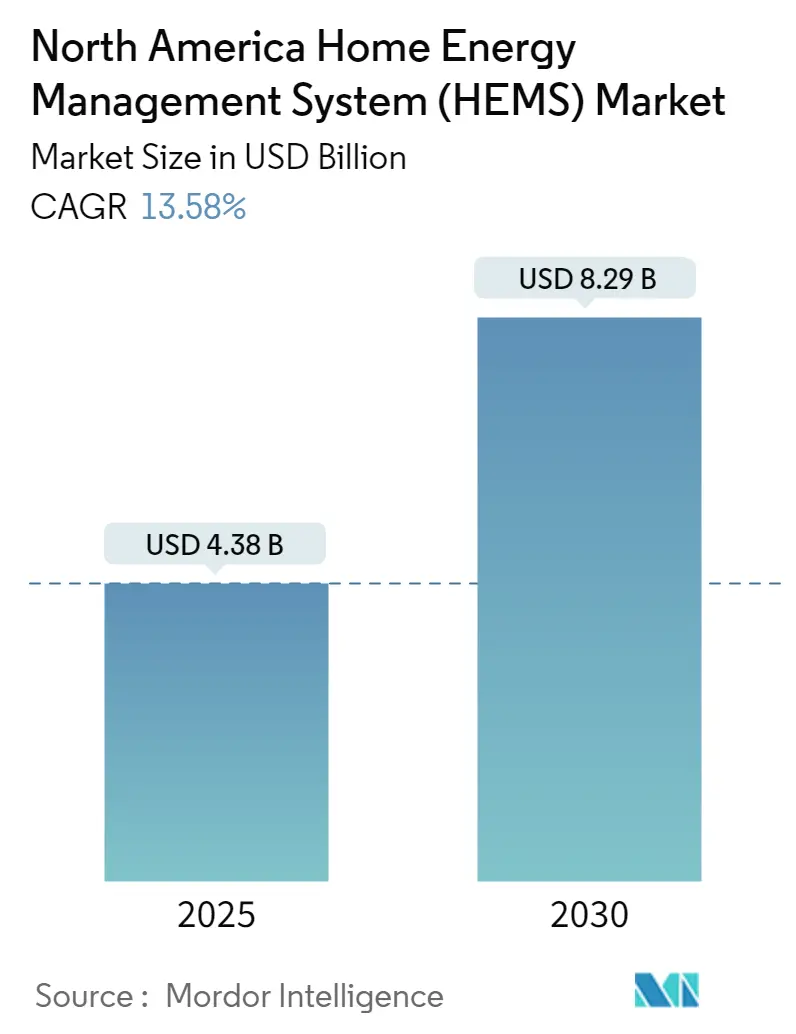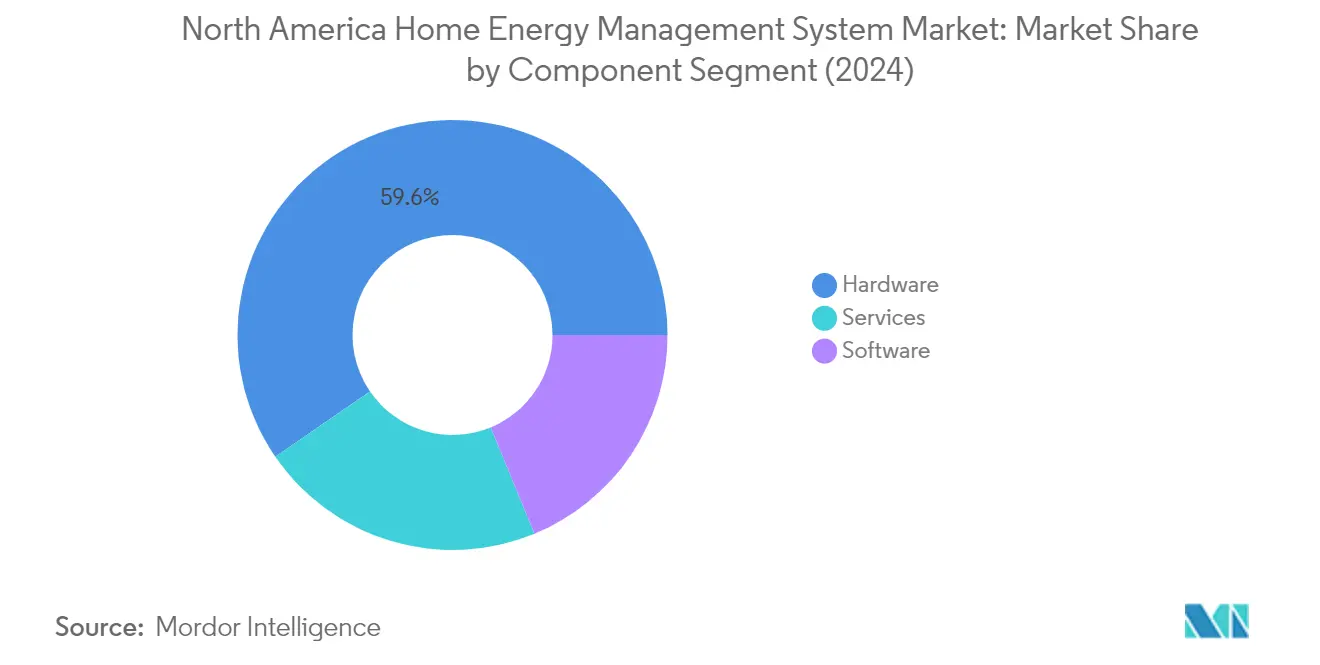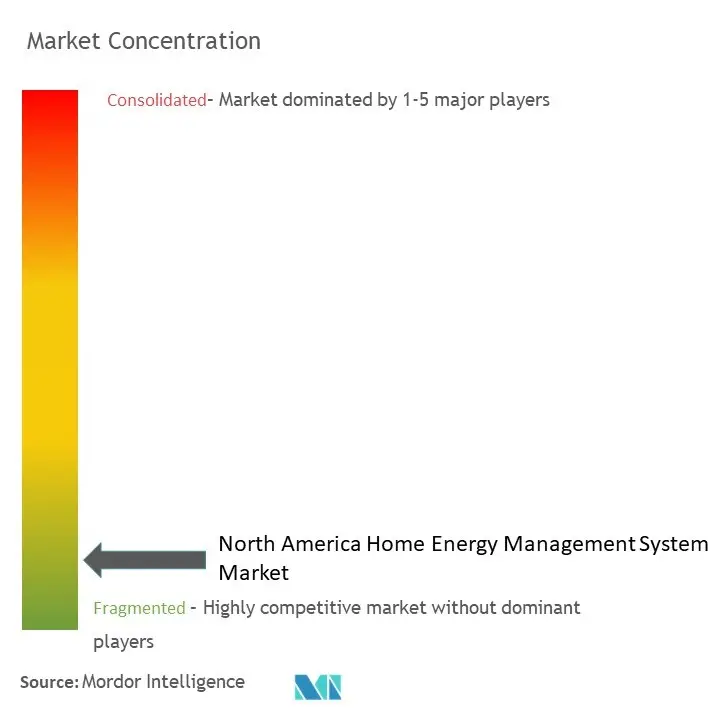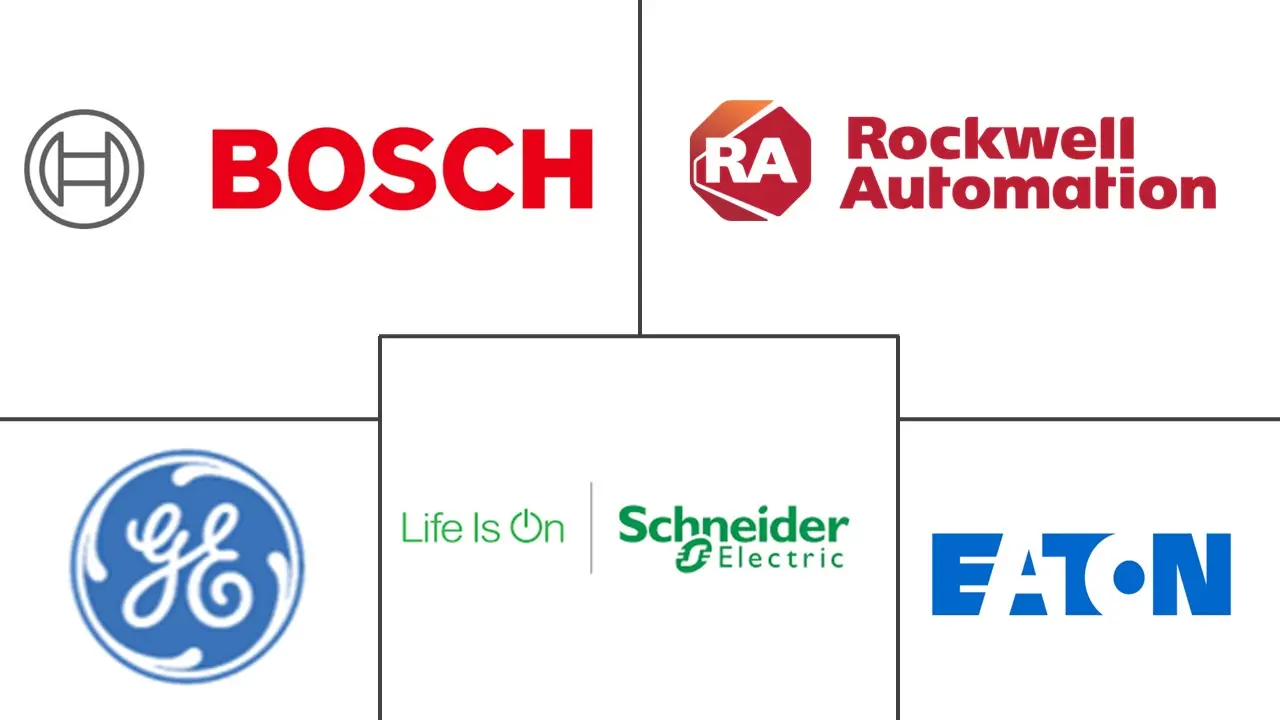North America Home Energy Management System (HEMS) Market Size and Share

North America Home Energy Management System (HEMS) Market Analysis by Mordor Intelligence
The North America Home Energy Management System Market size is estimated at USD 4.38 billion in 2025, and is expected to reach USD 8.29 billion by 2030, at a CAGR of 13.58% during the forecast period (2025-2030).
The home energy management landscape is experiencing rapid transformation driven by increasing smart home technology adoption and changing consumer preferences. According to OBERLO, 60.4 million US homes are actively utilizing smart home devices in 2023, representing 46.5% of all households. This widespread adoption is reshaping how homeowners interact with and manage their energy consumption, leading to the development of more sophisticated and integrated energy management systems for home. The integration of Internet of Things (IoT) technology has enabled enhanced connectivity between various home systems, allowing for more precise control and monitoring of energy usage through centralized platforms.
Energy consumption patterns in residential sectors continue to evolve, presenting both challenges and opportunities for home energy management solutions. The U.S. Department of Energy reports that heating and cooling systems account for approximately 50% of a typical home's energy usage, highlighting the critical need for efficient home energy management systems. This significant energy consumption has led to the development of more advanced control systems and monitoring solutions that can help homeowners optimize their energy usage. The integration of artificial intelligence and machine learning capabilities has enabled these systems to provide more accurate predictions and automated adjustments based on usage patterns.
Technological advancements in the industry have focused on improving system efficiency and user experience through innovative features and capabilities. According to the U.S. Department of Energy, smart HVAC systems have demonstrated the potential to decrease energy usage by up to 25% through intelligent control and optimization. The industry has witnessed significant progress in the development of connected, intelligent devices such as smart sensors and thermostats, which are continuously being enhanced with improved power monitoring and display technologies. These advancements are enabling more precise home energy monitoring systems and creating opportunities for substantial cost savings for homeowners.
Recent industry developments have been characterized by strategic partnerships and innovative product launches aimed at enhancing energy management systems for home capabilities. In January 2024, Honeywell launched Advanced Control for Buildings, incorporating the latest technologies through strategic alliances with semiconductor manufacturers NXP Semiconductors N.V. and Analog Devices, Inc. Similarly, in December 2023, Ford and Resideo Technologies announced a joint partnership to study vehicle-to-home energy management through their EV-Home Power Partnership initiative. These collaborations demonstrate the industry's focus on developing integrated solutions that can address the growing complexity of home energy management systems while improving efficiency and user experience.
North America Home Energy Management System (HEMS) Market Trends and Insights
Increasing Usage of Smart Grids and Smart Meters
The rapid transition towards smart grids and home energy management systems is fundamentally transforming how residential energy consumption is monitored and managed across North America. According to recent data, United States electric utilities had approximately 119 million Advanced Metering Infrastructure (AMI) installations in 2022, representing around 72% of total electric meter installations. The residential sector dominated this transition, accounting for 88% of total AMI installations, with nearly 73% of total residential electric meters being Advanced Metering Infrastructure meters. This widespread adoption enables real-time monitoring of energy consumption patterns and facilitates two-way communication between utilities and consumers, creating opportunities for more efficient residential energy management.
Smart meters give utilities immediate access to data for better demand projection from the grid, particularly crucial during peak usage periods such as hot or humid days when the grid becomes strained. These advanced systems help utilities make informed decisions about energy production and consumption reduction among customers, avoiding the need to rely on environmentally unfriendly coal-fired plants during peak demands. The integration of smart grid technologies has demonstrated significant potential for consumer engagement in energy management systems, as evidenced by US Department of Energy research findings where consumers showed readiness to regulate energy consumption based on utility pricing, resulting in up to 10% savings on energy bills while reducing overall energy consumption.
Rising Investments in Energy Efficiency
The increasing focus on energy efficiency investments is driving significant transformations in residential energy management across North America. The US Department of Energy reports that smart HVAC systems alone can decrease energy usage by up to 25% through the examination of external variables such as weather conditions, occupancy, and indoor air quality. This potential for savings has been further incentivized by government initiatives, particularly the Inflation Reduction Act of 2022, which offers households substantial tax credits equal to 30% of installation costs for high-efficiency products, with maximums of USD 600 for qualified air conditioners and furnaces and USD 2,000 for qualified heat pumps.
The commitment to energy efficiency is further demonstrated through federal programs extending through 2032, providing up to USD 3,200 annually to reduce the cost of energy-efficient home modifications by up to 30%. These incentives cover a comprehensive range of improvements, including heat pump installations, insulation, door and window upgrades, electrical panel improvements, and home efficiency audits. Additionally, the Residential Clean Energy credit offers a 30% income tax credit for clean energy equipment such as rooftop solar, wind energy, and geothermal heat pumps, though this will be reduced to 26% and 22% in subsequent years. The integration of IoT sensors in home energy management systems has shown remarkable potential, with the US Department of Energy indicating that such installations in buildings might result in up to 30% energy savings through automated adjustments based on occupancy, climate conditions, and other factors.
Segment Analysis: By Component
Hardware Segment in North America Home Energy Management System Market
The hardware segment dominates the North America home energy management system (HEMS) market, commanding approximately 60% market share in 2024. This segment encompasses critical components such as sensors, thermostats, lighting panels, and other essential energy management system elements. The hardware components are fundamental to the system's functionality, as they facilitate continuous home monitoring and provide vital information about potential opportunities and risks. Energy monitoring hardware integrated with the system serves as the primary energy source, while power monitoring units transmit collected data into the system. The evolution of IoT sensors has particularly strengthened this segment, as their integration allows automatic adjustment of energy usage based on occupancy, climate conditions, and other factors. According to recent industry estimates, incorporating IoT sensors in buildings can result in up to 30% energy savings, highlighting the significant impact of hardware components in residential energy management market solutions.

Software Segment in North America Home Energy Management System Market
The software segment is experiencing the most rapid growth in the North America home energy management system (HEMS) market, with a projected growth rate of approximately 16% from 2024 to 2029. This remarkable growth is driven by the increasing adoption of emerging technologies such as AI, machine learning, and cloud computing in home energy management system solutions. Software systems are becoming increasingly sophisticated, offering capabilities for storing energy parameters, analyzing energy consumption, recognizing areas of energy wastage, decreasing energy consumption, forecasting electrical system performance, and improving energy usage to reduce costs for electrical loads. The segment's growth is further accelerated by the development of cloud-based energy management systems, which provide remote access to vital energy-related data and tools, eliminating geographical constraints and offering comprehensive features such as data collection from sensors, smart meters, secure storage, and real-time reporting.
Remaining Segments in Component Segmentation
The services segment plays a vital role in the North America home energy management system market, offering essential support through installation, maintenance, and monitoring services. This segment is particularly crucial in the context of increasing demand for energy-efficient systems and the growing complexity of home energy management solutions. Service providers offer expertise in system optimization, regular maintenance, and continuous monitoring to ensure optimal performance of energy management systems. The segment's importance is further emphasized by the rising need for professional support in integrating various components of energy management systems and ensuring their efficient operation in both new installations and retrofit projects.
Segment Analysis: By Product Type
Intelligent HVAC Controllers Segment in North America Home Energy Management System Market
The Intelligent HVAC Controllers segment dominates the North America home energy management system market, commanding approximately 36% market share in 2024. This significant market position is driven by the increasing adoption of smart HVAC systems in residential buildings across the United States and Canada. The segment's growth is supported by government initiatives promoting energy-efficient HVAC systems and rising consumer awareness about energy conservation. These controllers leverage advanced technologies like artificial intelligence and IoT to optimize heating, ventilation, and air conditioning operations, resulting in substantial energy savings for homeowners. The integration of intelligent HVAC controllers with other smart home devices and their ability to provide real-time monitoring and automated temperature control has made them an essential component of the modern smart home energy management device market.
Self-Monitoring Systems and Services Segment in North America Home Energy Management System Market
The Self-Monitoring Systems and Services segment is projected to experience the highest growth rate of approximately 16% during the forecast period 2024-2029. This remarkable growth is attributed to the increasing consumer preference for autonomous home monitoring solutions and the rising adoption of IoT-enabled devices. The segment's expansion is further fueled by technological advancements in sensor technology, data analytics, and mobile applications that enable homeowners to monitor and control their energy consumption remotely. The integration of artificial intelligence and machine learning capabilities in these systems enhances their ability to provide personalized energy optimization recommendations and automated responses to usage patterns. Additionally, the growing focus on energy conservation and the desire for greater control over household energy consumption continue to drive innovation in this segment.
Remaining Segments in Product Type Segmentation
The remaining segments, including Lighting Controls, Programmable Communicating Thermostats (PCTs), and Advanced Central Controllers, each play vital roles in the comprehensive home energy management ecosystem. Lighting Controls contribute significantly by enabling automated and efficient management of residential lighting systems, while PCTs offer sophisticated temperature control capabilities with communication features for enhanced energy optimization. Advanced Central Controllers serve as the backbone of integrated home energy management systems, facilitating seamless coordination between various smart devices and subsystems. These segments collectively enhance the overall functionality and efficiency of home energy management systems, providing homeowners with diverse options for managing their energy consumption based on their specific needs and preferences.
Segment Analysis: By Technology
Wi-Fi Segment in North America Home Energy Management System Market
Wi-Fi technology dominates the North American home energy management system market, holding approximately 35% market share in 2024. This significant market position is driven by Wi-Fi's widespread adoption in residential buildings and its reliability in providing connectivity for energy management devices. The technology's popularity is further enhanced by its ability to handle bandwidth-intensive applications and its compatibility with various smart home devices. Wi-Fi's prominence in the market is supported by continuous technological advancements, such as the introduction of Wi-Fi 7 and Wi-Fi HaLow, which offer improved range and stability for home networks. Major appliance manufacturers consider Wi-Fi a suitable technology for efficient home appliances as it helps conserve energy and contributes to successful smart grid implementation. The technology's ability to facilitate seamless communication between appliances and its established infrastructure in homes makes it a preferred choice for consumers and manufacturers alike.
Z-Wave Segment in North America Home Energy Management System Market
The Z-Wave technology segment is emerging as the fastest-growing technology in the home energy management system market, demonstrating strong growth potential from 2024 to 2029. Operating at a 908.42 MHz frequency band in the United States and Canada, Z-Wave offers superior performance in penetrating walls and objects, making it highly reliable for home automation applications. The technology's growth is driven by its mesh networking capabilities, allowing up to 232 devices to connect within a range of 330 feet, facilitating robust and reliable device interactions in residential settings. Z-Wave's adoption is further accelerated by its enhanced security protocols, power optimization features, and compatibility assurance across different devices. The technology's ability to provide consumers with quantified data for energy conservation decisions and its role in facilitating efficient household energy management make it increasingly attractive to homeowners looking for comprehensive energy management solutions.
Remaining Segments in Technology
The other significant technologies in the North American home energy management system market include ZigBee, Internet, and other emerging technologies. ZigBee technology is particularly valued for its low power consumption and ability to create mesh networks for home automation. The Internet segment plays a crucial role in enabling cloud-based energy management solutions and remote monitoring capabilities. Other technologies, including Bluetooth and HomePlug, contribute to the market by offering specialized solutions for specific use cases. These technologies complement each other in the market, providing consumers with diverse options for implementing home energy management systems based on their specific needs and preferences. The coexistence of these technologies ensures that homeowners have flexibility in choosing solutions that best match their requirements for energy monitoring, control, and optimization.
North America Home Energy Management System Market Geography Segment Analysis
Home Energy Management System Market in the United States
The United States dominates the North American energy management system market size by country, accounting for approximately 91% of the total market value in 2024. The growth in this home energy market is primarily driven by increasing residential users and a growing demand for energy efficiency goals, renewable energy integration, and smart home integration. The country's commitment to energy sustainability is evident through various government initiatives, including the Department of Energy's recent commitment of USD 46 million to fund 29 projects across 15 states for developing advanced building technologies. The increasing adoption of renewable energy sources, particularly solar panels in residential properties, has created a substantial demand for home energy management systems to monitor, manage, and optimize energy production and consumption. The market is further strengthened by federal income tax credits and incentives for energy-efficient products, such as the Inflation Reduction Act of 2022, which offers households significant tax credits for installing energy-efficient systems. Rising disposable income, increasing construction activity, and shifting weather patterns continue to drive industry expansion, while smart home and smart city projects provide additional momentum to market growth. Leading energy management companies in the USA are playing a pivotal role in this transformation.
Home Energy Management System Market in Canada
Canada represents a dynamic and rapidly evolving market for home energy management systems, projected to grow at approximately 18% CAGR from 2024 to 2029. The country's market is experiencing significant transformation driven by the active promotion of renewable energy sources and the modernization of the electrical grid. The Canadian government's commitment to energy efficiency is demonstrated through various initiatives such as the Clean Home Initiative and the Canada Greener Homes Grant, which provide substantial incentives for homeowners adopting energy-efficient solutions. The modernization of the electrical grid presents significant opportunities for home energy management systems, particularly in integrating with smart grids and participating in demand response programs. The Maritime Electric Company's recent USD 47.6 million project to transform the island's electricity grid system exemplifies the country's commitment to building more efficient and resilient energy infrastructure. The market is further bolstered by the country's focus on green building construction projects and the implementation of programs like Enbridge Gas's collaboration with the Ontario government to provide incentives for smart control installations. This growth underscores the importance of the residential energy service market in Canada.
Home Energy Management System Market in North America - Regional Analysis
The North American home energy management system market demonstrates a robust ecosystem spanning the United States and Canada, with both countries showing a strong commitment to energy efficiency and sustainability goals. The region's market is characterized by increasing integration of smart grid technologies, growing adoption of renewable energy sources, and rising awareness about energy conservation. Both countries are witnessing significant developments in terms of government support, technological advancement, and consumer awareness regarding energy management solutions. The market benefits from the region's strong focus on reducing carbon emissions, modernizing grid infrastructure, and promoting smart home technologies. The collaborative approach between utility companies, technology providers, and government agencies in both countries has created a favorable environment for market growth. The region's commitment to environmental sustainability, coupled with increasing consumer demand for energy-efficient solutions, continues to drive innovation and adoption of home energy management systems across both markets. This comprehensive approach is vital for effective energy market management.
Competitive Landscape
Top Companies in North America Home Energy Management Systems Market
The market features prominent players like Bosch, Rockwell Automation, General Electric, Schneider Electric, Eaton Corporation, SAP SE, Siemens AG, ABB, Oracle Corporation, and Honeywell International. These companies are actively pursuing product innovation through the development of advanced residential energy management systems solutions incorporating IoT connectivity, AI capabilities, and cloud integration. Strategic partnerships with utilities and technology providers have become increasingly common to enhance solution capabilities and market reach. Companies are focusing on expanding their product portfolios through both organic development and acquisitions, particularly in areas like smart meters, home automation, and renewable energy integration. Operational agility is demonstrated through rapid product launches, system upgrades, and the ability to adapt to changing consumer preferences for energy efficiency and sustainability. The competitive landscape is characterized by continuous investment in R&D, with companies developing more sophisticated and user-friendly interfaces for their energy management solutions.
Market Dominated by Diversified Technology Leaders
The North American home energy management systems market is primarily dominated by large multinational conglomerates with diverse technology portfolios, rather than specialized players. These established companies leverage their extensive research capabilities, strong distribution networks, and deep market understanding to maintain their competitive positions. The market shows a moderate level of consolidation, with major players controlling significant market share through their comprehensive product offerings and established brand presence. Merger and acquisition activities are focused on acquiring innovative startups and technology companies to enhance existing capabilities and expand into emerging market segments.
The competitive dynamics are shaped by the presence of both traditional industrial automation companies and newer technology-focused enterprises. Companies with strong backgrounds in building automation and energy management systems have a natural advantage, while IT and software companies are increasingly gaining ground through their expertise in data analytics and cloud solutions. Strategic partnerships and collaborations between hardware manufacturers and software providers are becoming more common, creating integrated solutions that address the full spectrum of smart home energy management system market needs.
Innovation and Integration Drive Market Success
Success in this market increasingly depends on the ability to provide integrated solutions that combine hardware, software, and services. Incumbent players must focus on continuous innovation, particularly in areas such as artificial intelligence, machine learning, and predictive analytics, while maintaining strong relationships with utilities and energy service providers. The development of open platforms that can integrate with various third-party devices and systems is becoming crucial for market success. Companies must also invest in strengthening their cybersecurity capabilities and ensuring compliance with evolving data privacy regulations.
For contenders looking to gain market share, differentiation through specialized solutions or focus on underserved market segments presents opportunities. Success factors include developing user-friendly interfaces, providing exceptional customer support, and offering competitive pricing models. The ability to demonstrate clear energy savings and return on investment to end-users is crucial, as is the capability to adapt to changing regulatory requirements regarding energy efficiency and grid integration. Companies must also consider the growing importance of renewable energy integration and electric vehicle charging capabilities in their product development strategies. As the market evolves, identifying the top home energy management systems will be key to staying competitive.
North America Home Energy Management System (HEMS) Industry Leaders
-
Robert Bosch GMBH
-
Rockwell Automation Inc.
-
General Electric Company
-
Schneider Electric SE
-
Eaton Corporation PLC
- *Disclaimer: Major Players sorted in no particular order

Recent Industry Developments
- December 2023 - Canadian Solar Inc. announced that e-STORAGE, which is part of the Company's majority-owned subsidiary CSI Solar Co. Ltd, will launch SolBank 3.0, the latest iteration of its utility-scale energy storage system. With a power of up to 2.35 MW and a capacity of 5 MWh, SolBank 3.0 seamlessly integrates high energy density cells, an advanced safety system, smart liquid cooling, and active balance system controls.
- October 2023 - Enphase Energy Inc. announced the availability of the Enphase IQ E.V. Charger in the United States and Canada. The I.Q. E.V. Charger is Wi-Fi-enabled and includes smart control and monitoring capabilities. The charger can also seamlessly integrate into Enphase's solar and battery system to help homeowners maximize electricity cost savings by charging directly from solar energy.
North America Home Energy Management System (HEMS) Market Report Scope
A home energy management system (HEMS) is a digital system that monitors and controls household energy generation, storage, and consumption. HEMS usually optimizes for a purpose such as cost reduction, self-sufficiency maximization, or emissions depreciation. HEMS is evolving and gaining more popularity with the rise in adoption of electric mobility and heating, residential PV, and dynamic tariffs, as it increases the saving potential.
The North American home energy management system market is segmented by component (hardware, software, and services), product type (lighting controls, self-monitoring systems and services, programmable communicating thermostats, advanced central controllers, and intelligent HVAC controllers), technology (ZigBee, Wi-Fi, internet, Z-Wave, and other technologies), and country (United States, and Canada). The report offers market forecasts and size in value (USD) for all the above segments.
| Hardware |
| Software |
| Services |
| Lighting Controls |
| Self-Monitoring Systems and Services |
| Programmable Communicating Thermostats |
| Advanced Central Controllers |
| Intelligent HVAC Controllers |
| ZigBee |
| Wi-Fi |
| Internet |
| Z-Wave |
| Other Technologies |
| United States |
| Canada |
| By Component | Hardware |
| Software | |
| Services | |
| By Product Type | Lighting Controls |
| Self-Monitoring Systems and Services | |
| Programmable Communicating Thermostats | |
| Advanced Central Controllers | |
| Intelligent HVAC Controllers | |
| By Technology | ZigBee |
| Wi-Fi | |
| Internet | |
| Z-Wave | |
| Other Technologies | |
| By Country | United States |
| Canada |
Key Questions Answered in the Report
How big is the North America Home Energy Management System Market?
The North America Home Energy Management System Market size is expected to reach USD 4.38 billion in 2025 and grow at a CAGR of 13.58% to reach USD 8.29 billion by 2030.
What is the current North America Home Energy Management System Market size?
In 2025, the North America Home Energy Management System Market size is expected to reach USD 4.38 billion.
Who are the key players in North America Home Energy Management System Market?
Robert Bosch GMBH, Rockwell Automation Inc., General Electric Company, Schneider Electric SE and Eaton Corporation PLC are the major companies operating in the North America Home Energy Management System Market.
What years does this North America Home Energy Management System Market cover, and what was the market size in 2024?
In 2024, the North America Home Energy Management System Market size was estimated at USD 3.79 billion. The report covers the North America Home Energy Management System Market historical market size for years: 2019, 2020, 2021, 2022, 2023 and 2024. The report also forecasts the North America Home Energy Management System Market size for years: 2025, 2026, 2027, 2028, 2029 and 2030.
Page last updated on:



